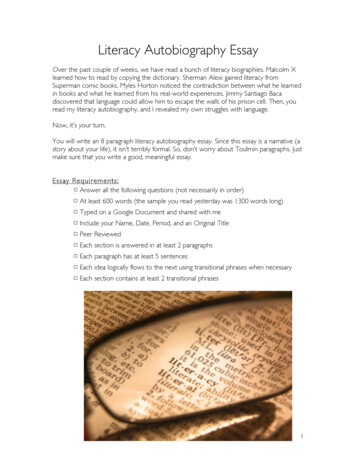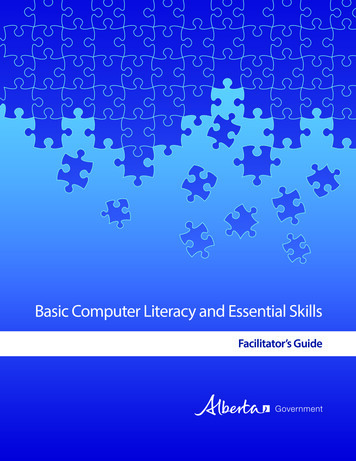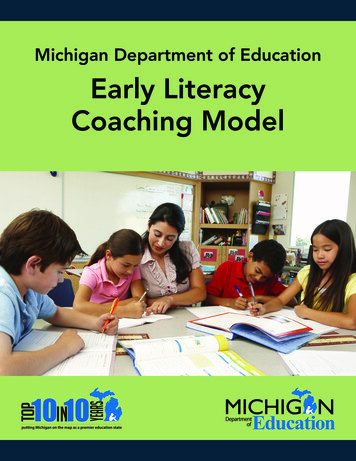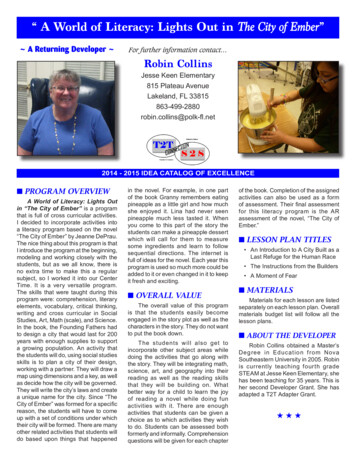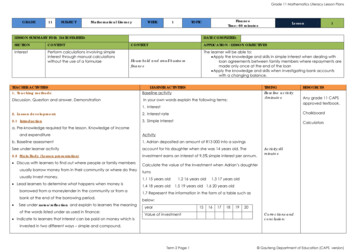
Transcription
Grade 11 Mathematics Literacy Lesson PlansGRADE11SUBJECTMathematical LiteracyWEEK1LESSON SUMMARY FOR: DATE STARTED:SECTIONCONTENTInterestPerform calculations involving simpleinterest through manual calculationswithout the use of a formulaeFinanceTime: 60 minutesTOPICLessonDATE COMPLETED:CONTEXTAPPLICATION /LESSON OBJECTIVESHousehold and small businessfinanceThe learner will be able to: Apply the knowledge and skills in simple interest when dealing withloan agreements between family members where repayments aremade only once at the end of the loan Apply the knowledge and skills when investigating bank accountswith a changing balance.TEACHER ACTIVITIES1. Teaching methods:LEARNER ACTIVITIESBaseline activityDiscussion, Question and answer, DemonstrationIn your own words explain the following terms:TIMINGBaseline activity:5minutes1. InterestRESOURCESAny grade 11 CAPSapproved textbook.2. Lesson development:2. Interest rateChalkboard2.1 Introduction3. Simple interestCalculatorsa. Pre-knowledge required for the lesson. Knowledge of incomeand expenditureActivityb. Baseline assessment1. Adrian deposited an amount of R13 000 into a savingsSee under learner activityaccount for his daughter when she was 14 years old. The2.2 Main Body (Lesson presentation)investment earns an interest of 9,5% simple interest per annum. Discuss with learners to find out where people or family membersusually borrow money from in their community or where do theyusually invest money. Lead learners to determine what happens when money isborrowed from a moneylender in the community or from abank at the end of the borrowing period. 1See under notes/reflection and explain to learners the meaningof the words listed under as used in finance: Indicate to learners that interest can be paid on money which isActivity:45minutesCalculate the value of the investment when Adrian’s daughterturns1.1 15 years old1.4 18 years old1.2 16 years old1.3 17 years old1.5 19 years old 1.6 20 years old1.7 Represent the information in the form of a table such asbelow:year15Value of investment1617181920Corrections andconclusion:invested in two different ways – simple and compound.Term 2 Page 1 Gauteng Department of Education (CAPS version)
Grade 11 Mathematics Literacy Lesson Plans Explain to learners that with simple interest, the interest earned orpaid on amount invested or borrowed stays the same. Demonstrate to learners how simple interest is calculated. Anexample is given below:2. Joshua borrows his niece R200 for two years at a rate of 7%simple interest. Below is a table showing Joshua’s moneyincrease in the first two yearsYear12Amount at the start ofR200R214Interest earnedR14R141. one yearTotal amount at theR214R2282. two yearsend of the yearWorked exampleShafique borrowed R350,00 from his nephew at a simple interestrate of 6% per annum. Calculate the interest he has to pay if theloan is repaid after10minutes34the year3. three monthsSolution2.1 Copy and complete the table by filling in the amount ofThe 6% is the interest rate and the interest is 6% of R350,00.money Joshua would have earned at the end of each yearInterest per year 6/ 100 x R350,00 R21,00.from year 2 to year 10.Therefore the interest after1.one year R21,002.two years 2 x R21,00 R42,003.three months 3/ 12 x R21,00 R5,25Or three months ¼ of R21,00 R5,25 Gives learners the task to complete under learner activity. Move round the class if possible to monitor learners performanceand provide assistance where needed. Learners exchange their work at the end of the activity andmonitor them to do peer marking. Give them homework based on the lesson presented.2.3 Conclusion Summarise the lesson by highlighting the key points to considerwhen dealing with borrowing and lending money.Term 2 Page 2 Gauteng Department of Education (CAPS version)
Grade 11 Mathematics Literacy Lesson PlansReflections/notes: Borrower – the person who borrows money from somebody Lender - the person/institution who lends money to the borrower. The money must be paid back. Loan term – the period over which the money may be paid back Interest is the amount of money paid in return for the use of someone else’s money. Interest rate is the rate at which interest is paid by a borrower for the use of money that they borrow from a lender. Stress that an interest rate is not an amount but a percentagesuch as 3%. Repayment – the regular payment on the outstanding balance. Per annum – per yearName of Teacher:HOD:Sign:Sign:Date:Date:Term 2 Page 3 Gauteng Department of Education (CAPS version)
Grade 11 Mathematics Literacy Lesson PlansGRADE11SUBJECTMathematical LiteracyWEEK1LESSON SUMMARY FOR: DATE STARTED:SECTIONCONTENTSimple interestPerform calculations involving simpleinterest through manual calculationswithout the use of a formulaeFinanceTime: 60 minutesTOPICLesson2DATE COMPLETED:CONTEXTAPPLICATION /LESSON OBJECTIVESHousehold and small businessfinanceThe learner will be able to: Apply the knowledge and skills in simple interest when dealingwith loan agreements between family members whererepayments are made only once at the end of the loan Represent simple interest growth scenarios using linear graphs.TEACHER ACTIVITIESLEARNER ACTIVITIES1. Teaching methods:Baseline activityDiscussion, Question and answer, DemonstrationCorrections to be done for the previousTIMINGBaseline activity:5minuteslesson’s home worka. Pre-knowledge required for the lesson.Knowledge of simple interestb. Baseline assessmentSee under learner activityActivity1.1 Calculate the value of the investmentfor one year up to six years.1.2 Draw up your own table for 6 years for Explain to learners that with simple interest the same amount each yearsimple interest to show the years of Discuss with learners to determine why it is sometimes better to take up loansCalculators1. Ndumiso invests R6 500 at 11% per year.2.2 Main Body (Lesson presentation)because the interest is calculated on the same lump sum for every year.Any grade 11 CAPSapproved textbook.Chalkboard2. Lesson development:2.1 IntroductionRESOURCESActivity:45minutesinvestment and the value of the investmentat the end of each investment period.or borrow money from family members.Term 2 Page 4 Gauteng Department of Education (CAPS version)
Grade 11 Mathematics Literacy Lesson Plans Explain that if one takes up a loan from a bank or financial institution, theperson needs to have proof of earnings and other guarantees before thebank or financial institution grants the loan. Therefore it might be a betteridea or easier to make an informal loan agreement with family members. Indicate to learners that linear graphs can be used to represent simple1.3 Represent the information from thetable in the form of a linear graph.1.4 How much was the investment at theend of the fifth year?10minutesinterest scenarios. Based on the previous lesson’s examples and the table of values supplied inCorrections andconclusion:1.5 How much interest did the investmentthe previous lesson, demonstrate how to present simple interest scenariosaccumulate at the end of the investmentusing linear graphs. See under reflections/notes.period? Show all calculations.See under learner activity to give learners work to do. Check learners performance and provide feedback where necessary. Append your signature to the learners work and give them homework basedon the lesson presented.2.3 Conclusion Summarise the lesson by highlighting the key points to consider when dealingwith borrowing and lending money.Reflections/notes:Joshua borrows his niece R200 for two years at a rate of 7% simple interest. Below is a table showing Joshua’s money increase in the first two yearsYear1234567Amount at the start of the yearR200R214R228R242R256R270R284Interest earnedR14R14R14R14R14R14R14Total amount at the end of the yearR214R228R242R256R270R284R298A linear graph to represent the information in the table is given below:Term 2 Page 5 Gauteng Department of Education (CAPS version)
Grade 11 Mathematics Literacy Lesson Plansvalue of investmentinvestment growth at 7% simple 1234567years of investmentName of Teacher:HOD:Sign:Sign:Date:Date:Term 2 Page 6 Gauteng Department of Education (CAPS version)
Grade 11 Mathematics Literacy Lesson PlansGRADE11SUBJECTMathematical LiteracyWEEK1LESSON SUMMARY FOR: DATE STARTED:SECTIONCONTENTSimple interestPerform calculations involvingcompound interest through manualcalculations without the use of aformulaeFinanceTime: 60 minutesTOPICLesson3DATE COMPLETED:CONTEXTAPPLICATION /LESSON OBJECTIVESHousehold and small businessfinanceThe learner will be able to: Apply the knowledge and skills in compound interest whendealing with loan agreements between family memberswhere repayments are made only once at the end of the loan Represent compound interest growth scenarios using graphsshowing compound change.TEACHER ACTIVITIESLEARNER ACTIVITIES1. Teaching methods:Baseline activityDemonstration, Discussion, Question and answerCorrections to be done for the previous lesson’s homeTIMINGBaseline activity:5minutesworka. Pre-knowledge required for the lesson.Knowledge of simple interestb. Baseline assessmentSee under learner activity2.2 Main Body (Lesson presentation)ActivityCalculators1. Maxin invests R14 500 at 12% interest rate compoundedannually.1.1 Calculate the value of the investment for one year upActivity:45minutesto five years. Lead learners to explain what compound interest mean.1.2 Draw up your own table for five years for to show the Explain to learners that compound interest increases becauseyears of investment and the value of the investment atthe interest is added to the lump sum so you calculate theAny grade 11 CAPSapproved textbook.Chalkboard2. Lesson development:2.1 IntroductionRESOURCESthe end of each investment period.Term 2 Page 7 Gauteng Department of Education (CAPS version)
Grade 11 Mathematics Literacy Lesson Plansinterest on a bigger lump sum for every year. Demonstrate to learners how to calculate values involvingcompound interest. See under reflections/notes. Encouragelearners not round up until they get to the final value. Look under learner activity to give them work to do.1.3 Represent the information from the table in the form ofa graph.1.4 How much was the investment at the end of the fifthyear? Mark learners work and do corrections with them.1.5 How much interest did the investment accumulate at Give learners home work.Corrections andconclusion:10minutesthe end of the investment period?2.3 Conclusion Summarise the lesson by highlighting the key points to considerwhen working with compound interest.Reflections/notes:Jacob invests R13 000 in an account at an interest rate of 8,5% compounded annually.1 calculate the interest rate after 1 year2 determine the amount on which the interest for the second year will be calculated3 copy and complete the table below:End of year0123Interest earned for the year0R1 147,50Value of the investment in RandR13 500R14 647,5045Suggested solution1. Interest after 1 year 8,5% of R13 500 8,5 100 x R13 5002. Investment amount for the second year R13 500 R1 147,50 R1 147,50 R14 647,503. Calculation of values used in the tableEnd of year 2Interest in 2nd year 8,5% of R14 647,50 8,5 100 x R14 647,50 R1 245,04Investment amount at end of 2nd year/beginning 3rd year R14 647,50 R1 245,0375 R15 892,5375Term 2 Page 8 Gauteng Department of Education (CAPS version)
Grade 11 Mathematics Literacy Lesson PlansEnd of year 3Interest in 3rd year 8,5% of R15 892,5375 8,5 100 x R15 892,5375 R1 350,865688Investment amount at end of 3nd year/beginning 4th year R15 892,55375 R1 350,865688 R17 243,40319End of year 4Interest in 4th year 8,5% of R17 243,41 8,5 100 x R17 243,40319Investment amount at end of4thyear/beginning5th R1 465,689271year R17 243,40319 R1 465,689271 R18 709,09246End of year 5Interest in 5th year 8,5% of R18 709,09246 8,5 100 x R18 709,09246 R1 590,272859Investment amount at end of 5th year R20 299,36532 R18 709,09246 R1 590,272859 R20 299,37Name of Teacher:HOD:Sign:Sign:Date:Date:Term 2 Page 9 Gauteng Department of Education (CAPS version)
Grade 11 Mathematics Literacy Lesson PlansGRADE11SUBJECTMathematical LiteracyWEEK1LESSON SUMMARY FOR: DATE STARTED:SECTIONCONTENTInterest onfixed deposits Perform calculations involving simpleinterest and compound interest throughmanual calculations without the use offormulae. Determine the interest on fixed depositsTEACHER ACTIVITIESFinanceTime: 60minutesTOPICCONTEXTAPPLICATION /LESSON OBJECTIVESHousehold and small businessfinanceThe learner will be able to: Investigate investments in fixed deposit accounts where money isdeposited and withdrawn from the account only once.LEARNER ACTIVITIESBaseline activityBrainstorming, Discussion, Question and answer, DemonstrationCorrections to be done for the previous lesson’s home work2. Lesson development:Activitya. Pre-knowledge required for the lesson.Knowledge of simple interest and compound interest.b. Baseline assessmentSee under learner activity2.2 Main Body (Lesson presentation) Brainstorm with learners to determine whether they knowdifferent ways of saving money. Indicate to learners the two different ways of saving money.4DATE COMPLETED:1. Teaching methods:2.1 IntroductionLessonTIMINGBaseline activity:5minutesRESOURCESAny grade 11 CAPSapproved textbook.ChalkboardCalculators1. Anele inherits R35 000 from a trust fund. The money isinvested in affixed deposit account that pays 8% interestp.a. simple interest. The amount is left in the account for 6years. Calculate the value of the investment at the end ofthe investment period.Activity:45minutes2. Ethan decides to save R150 every month in a bankstarting at the beginning of June.Use a table to record your calculations.See under reflections/notes.Term 2 Page 10 Gauteng Department of Education (CAPS version)
Grade 11 Mathematics Literacy Lesson Plans Guide learners to complete the table by determining in theremaining amounts. Give homework to learners.2.1 how much will Ethan have paid at the end of one year?Show calculations2.2 How much will Ethan have in his account at the end of2.3 Conclusionnext June?Corrections andconclusion:10minutes Summarise the lesson by highlighting the key points toconsider when dealing with interest on fixed deposits.Reflections/notes:You can save money in two different ways:By depositing a lump sum into an account and leaving it there for a fixed period of time to earn interest. For example depositing R700 into an account for four years.By making regular payments into an account over a period of time. For example, paying R100 a month into an account for four years.Worked exampleAt ABC bank, and initial deposit of R50 is required for a special savings account designed for young people. Interest is calculated at 12% p.a. compounded monthly.Felicia decides to save R80 per month at ABC bank.Determine how much Felicia will have at the end of 5 months.Suggested solutionTo convert an annual rate to monthly rate you must divide it by 12. Therefore 12% p.a. 12% 12 0,01% per month.Now to calculate the monthly interest you work out 0,01% of deposit amount, which is 0,01% x R80 R0,80The information can be presented in a table form as shown below:Remember the interest rate per month is 0,01% and she deposits R80 into the account every month.MonthAmount at the startInterest earnedNew deposit amount1R800,01 x R80 R0,80R802R160,800,01 x R160,80 R1,61R803R242,41R804R805R80Term 2 Page 11Total amount at the end of monthR160,80R242,41 Gauteng Department of Education (CAPS version)
Grade 11 Mathematics Literacy Lesson PlansName of Teacher:HOD:Sign:Sign:Date:Date:Term 2 Page 12 Gauteng Department of Education (CAPS version)
Grade 11 Mathematics Literacy Lesson PlansGRADE11SUBJECTMathematical LiteracyWEEK2LESSON SUMMARY FOR: DATE STARTED:SECTIONCONTENTBanking Identify and explain the terminologiesused in banking Identify different types of bankaccounts and investigate “savingsaccount”FinanceTime: 60 minutesTOPICLesson1DATE COMPLETED:CONTEXTAPPLICATION /LESSON OBJECTIVESPersonal, Household and smallbusiness financeTEACHER ACTIVITIESThe learner would be able to:Investigate the advantages and disadvantages of savings accountsregarding access to money, bank charges and interest ratesLEARNER ACTIVITIES1. Teaching methods:Baseline activityDiscussion, Question and answer, DemonstrationDo corrections for the previousTIMINGBaseline activity:5minuteslesson’s home workRESOURCESAny grade 11 CAPSapproved textbook.Chalkboard2. Lesson development:2.1 IntroductionActivitya. Pre-knowledge required for the lesson.Calculators1. Explain the following bakingKnowledge of interest and interest ratestermsb. Baseline assessmentLiquid assetsSee under learner activityOverdraft2.2 Main Body (Lesson presentation) Discuss with learners to identify the terminologies used in banking. Assist learners tomention some of these terms.Activity:45minutesCredit limitDebit card List some of the banking terms for learners and explain to them. See underBank chargereflection/notes for some of these terms and their explanations. Discuss with learners to give reasons why bank accounts are needed for individuals andTerm 2 Page 13 Gauteng Department of Education (CAPS version)
Grade 11 Mathematics Literacy Lesson Plansbusinesses or corporations. See under reflections/notes for some reasons. You may addyour own reasons. Assist learners to identify different types of bank accounts. See under reflections/notes.Stop order2. Compare the advantages See under learner activity to give learners work to do.and disadvantages of asavings account in a Monitor learners performance and provide assistance where needed. Let learners exchange their work at the end of the activity and monitor them to do peertabular formCorrections andconclusion:10minutesmarking. Append your signature to the learners work and give them homework based on thelesson presented. Give learners home work2.3 Conclusion Summarise the lesson by highlighting the key concepts presented in the lesson.Reflections/notes:Banking terms and their meaning Liquid assets – assets that are easily converted to cash Liquidity – it refers to the ease with which assets can be converted to cash. Overdraft – this is a loan from a bank that allows for a debit balance on a account Credit card – a small plastic card issued by a bank or other financial institution for the purpose of buying goods and services on credit Credit limit – it’s the maximum amount that a bank or financial institution will allow a client to borrow Debit card – a small plastic card issued by a bank or financial institution for the purpose of buying goods and services with money that comes directly from your bankaccount Deposit – putting money into an account Bank charge or transactional fee – an amount of money payable for bank services provided Withdrawal – taking money from an accountTerm 2 Page 14 Gauteng Department of Education (CAPS version)
Grade 11 Mathematics Literacy Lesson Plans Debit order – an instruction to a bank to pay an amount that differs from month to month to a person or a business. Stop order - an instruction to a bank to pay a fixed amount on a monthly basis to a person or business.Bank accounts offer a secure place for individuals, businesses or corporations to keep their money. Bank accounts differ and they don’t all allow for the same access tomoney or charge the same fees or give the same interest.There various types of bank accounts. These include current/cheque accounts, savings accounts, fixed deposit accounts, etc.Savings accountMost people open a savings account, which pays interest. The account is suitable for short-term savings (savings that will be used within a year for something like schoolfees).Below is a table comparing the advantages and disadvantages of a savings account:AdvantagesDisadvantagesThe account allows customers to earn money on their liquid assets in the form ofThe liquid assets cannot be used directly as moneyinterestIt allow regular access to moneyHas non cheque or credit card facilities for paymentsThe balance on the account can change daily and interest is calculated dailyInterest is only added onto the account at the end of the monthWithdrawals from savings account are occasionally costly and are sometimestime-consumingDue to liquidity of this type of account, interest rates are low.Name of Teacher:HOD:Sign:Sign:Date:Date:Term 2 Page 15 Gauteng Department of Education (CAPS version)
Grade 11 Mathematics Literacy Lesson PlansGRADE11SUBJECTMathematical LiteracyWEEK2FinanceTime: 60 minutesTOPICLESSON SUMMARY FOR: DATE STARTED:Lesson2DATE COMPLETED:SECTIONCONTENTCONTEXTAPPLICATION /LESSON OBJECTIVESBankingIdentify “fixed deposit account andcheques account” and describe themin terms of advantages anddisadvantages.Personal, Household and smallbusiness financeThe learner would be able to:Investigate the advantages and disadvantages of fixed deposit accountand cheques accounts regarding access to money, bank charges andinterest ratesTEACHER ACTIVITIESLEARNER ACTIVITIES1. Teaching methods:Discussion, Question and answer, DemonstrationActivityTIMINGBaseline activity:5minutes1. Describe fixed depositRESOURCESAny grade 11 CAPSapproved textbook.2. Lesson development:account in terms of theChalkboard2.1 Introductionadvantages andCalculatorsa. Pre-knowledge required for the lesson.disadvantages in a tabularKnowledge of savings accountsformb. Baseline assessment2. Compare cheque accountRefresh learners memory on savings accounts with their advantages and disadvantagesadvantages and2.2 Main Body (Lesson presentation)disadvantages in the form Discuss with learners what fixed deposit accounts and cheque accounts are. See underof a table.reflections/notes.Activity:45minutes3. Which of the two accounts Assist learners to identify the advantages and disadvantages of each type of account.will you advice a client who See under learner activity to give learners work to do.wants more interest to be Monitor learners performance and provide assistance where needed.paid on the account? GiveTerm 2 Page 16 Gauteng Department of Education (CAPS version)
Grade 11 Mathematics Literacy Lesson Plans Let learners exchange their work at the end of the activity and monitor them to do peerreasons for your answersmarking. Append your signature to the learners work and give them homework based on theCorrections andconclusion:lesson presented. Give learners home work10minutes2.3 Conclusion Summarise the lesson by highlighting the advantages and disadvantages of fixeddeposit and cheque accounts.Reflections/notes:Cheque accountIt is also called a transactional account and people use it to make regular transactions like withdrawals, deposits and payments.Fixed deposit accountThis account is used for savings that you leave for a fixed period of 3, 6, 12 or 36 months. The longer the investment period the larger the interest will normally be.Advantages and disadvantages of fixed deposit account and cheque accountFixed deposit accountCheque gesMoney can be deposited into theThe money cannot be withdrawn untilThe account provides funds forThey tend not to earn interest rateaccount either as a lump sum or everythe end of the stipulated time periodwithdrawal or payment in a variety ofbut attract high interest rates andmonth for a specific period of time atwhich can vary from one month to aforms including cheques, stop orderspenalties if overdrawna specific interest ratefew yearsdebit orders, electronic and/ortelephonic transfersIt offers a higher rate of interestOffers less liquidityIt is meant for the convenience of theTransaction fees are charged onindividual or business in terms of accessmost transactions in and out of theto funds when neededaccountTerm 2 Page 17 Gauteng Department of Education (CAPS version)
Grade 11 Mathematics Literacy Lesson PlansInterest is calculated daily but onlypaid into the account at the end ofeach month.Name of Teacher:HOD:Sign:Sign:Date:Date:Term 2 Page 18 Gauteng Department of Education (CAPS version)
Grade 11 Mathematics Literacy Lesson PlansGRADE11SUBJECTMathematical LiteracyWEEK2FinanceTime: 60minutesTOPICLESSON SUMMARY FOR: DATE STARTED:Lesson3DATE COMPLETED:SECTIONCONTENTCONTEXTAPPLICATION /LESSON OBJECTIVESBankingDescribe debit and credit cards in termsof their advantages and disadvantages.Personal, Household and smallbusiness financeThe learner would be able to:Investigate the advantages and disadvantages of debit and creditcards regarding access to money, bank charges and interest ratesTEACHER ACTIVITIESLEARNER ACTIVITIES1. Teaching methods:Baseline activityDiscussion, Question and answer, DemonstrationDo corrections for the previousTIMINGBaseline activity:10minuteslesson’s home workRESOURCESAny grade 11 CAPSapproved textbook.Chalkboard2. Lesson development:2.1 IntroductionActivitya. Pre-knowledge required for the lesson.Calculators1. List at least three similaritiesKnowledge of savings accountsbetween debit cards andb. Baseline assessmentcredit cardsSee under learner activity2. Compare debit card and2.2 Main Body (Lesson presentation)credit card by identifying Discuss with learners to find out how money can be accessed if one has an account withtheir advantages anda bank.Activity:30minutesMarking: 15disadvantages Indicate to learners that a bank card such as a credit card or a debit card is usually usedto access one’s money in one’s account. Remind learners that a debit card is a small plastic card issued by a bank or financialinstitution for the purpose of buying goods and services with money that comes directlyTerm 2 Page 19 Gauteng Department of Education (CAPS version)
Grade 11 Mathematics Literacy Lesson Plansfrom one’s own account. Explain that debit cards have tired interest rates (different interest rates in differentmonetary intervals). Again explain to learners that a credit card is a small plastic card that is issued by a bankconclusion:or financial institution for the purpose of buying goods and services on credit.5minutes Assist learners to compare debit with credit cards. See under reflection/notes for somesuggestions. See under learner activity to give learners work to do. Monitor learners performance and provide assistance where needed. Let learners to do peer marking. Give learners home work2.3 Conclusion Summarise the lesson by highlighting the advantages and disadvantages of debit cardsand credit cardsReflections/notes:Below is a table showing a comparison between debit card and creditComparisonAdvantages and disadvantagesDebit cardCredit cardDebit cardCredit cardCan withdraw money at ATMCan withdraw money at ATMCannot use to pay for urgent purchasesInterest rates charged on creditCan withdraw money inside the bankCan withdraw money inside the bankif no funds are availablebalances are very high.Can pay for shoppingCan pay for shoppingMay lead to temptations to buynon-essential things even whenmoney is not availableMay only spend the amount availableMay spend money that is not in theNo overdraft facilities are allowed onTerm 2 Page 20Each card is given a specified credit Gauteng Department of Education (CAPS version)
Grade 11 Mathematics Literacy Lesson Plansaccount but interest is payable ondebit cards and an account must alwayslimit which you can use to buythe outstanding amounts after ahave a credit balance, i.e. you cannotgoods and servicesspecified periodbuy on credit (using money that you donot have)The amount is immediately withdrawnThe account holder decides whenDebit cards usually attract bank chargesThis borrowed money must be paidfrom the current accountand how much to pay offor fees for all transactions.back within a specified periodNot a risk to fall in debt trapCan be used in a crisis to pay forThey are not designed for savings.purchases and/or services. Up to 55days interest freeBudget buying facilities spread costoutName of Teacher:HOD:Sign:Sign:Date:Date:Term 2 Page 21 Gauteng Department of Education (CAPS version)
Grade 11 Mathematics Literacy Lesson PlansGRADE11SUBJECTMathematical LiteracyWEEKLESSON SUMMARY FOR: DATE STARTED:SECTIONCONTENTBankingcharges andlate paymentsIdentify bank charges forspecified accounts anddetermine the implicationsfor late payments onaccounts.2TOPICFinanceTime: 60 minutesLesson4DATE COMPLETED:CONTEXTAPPLICATION /LESSON OBJECTIVESThe learner would be able to:Compare bank charges of different banks using tariff tables, given formulae and drawngraphs to assess the suitability of different accounts for individuals with particular needs.Personal, Household andsmall business financeInvestigate the implications of late payments on a credit card account.Investigate the different ways in which interest is calculated on different types of accountsTEACHER ACTIVITIESLEARNER ACTIVITIES1. Teaching methods:Baseline activityDiscussion, Question and answerDo corrections for the previous lesson’sTIMINGBaseline activity:10minuteshome worka. Pre-knowledge required for the lesson.Knowledge of debit and credit cardsActivityCalculators1. Benny has a credit card which he usesevery month to do his shopping. Inb. Baseline assessmentApril, he made a shopping costing R6See under learner activity560,50. He didn’t pay his account on2.2 Main Body (Lesson presentation)time and it was 7 days late. The bank Discuss with learners to find out what they know about bank charges. Assistcharges 26% p.a. interest calculatedthem to explain bank charges and if possible let them give examples. SeeAny grade 11 CAPSapproved textbook.Chalkboard2. Lesson development:2.1 IntroductionRESOURCESActivity:35minutesMarking: 10on a daily balance.Term 2 Page 22 Gauteng Department of Education (CAPS version)
Lender - the person/institution who lends money to the borrower. The money must be paid back. Loan term – the period over which the money may be paid back Interest is the amount of money paid in return for the use of someone else’s money. Interest rate is the rate at which interest is paid by a borr






